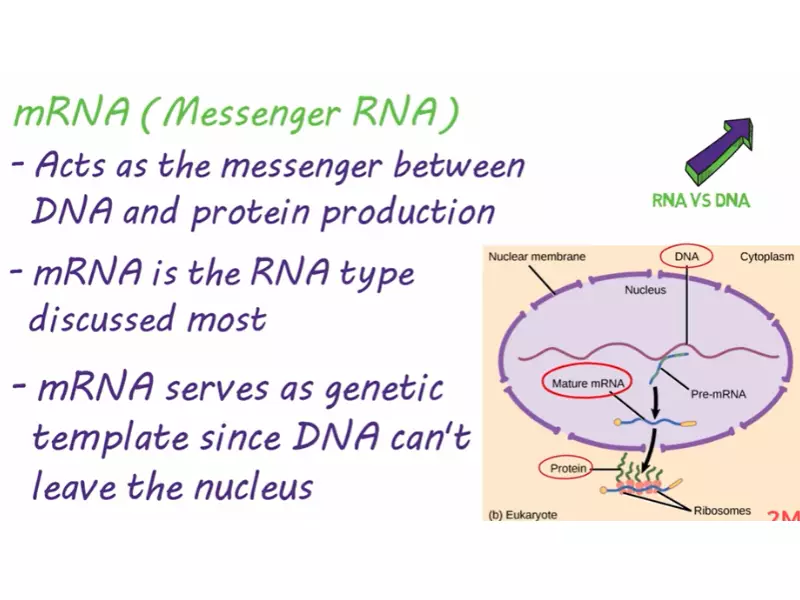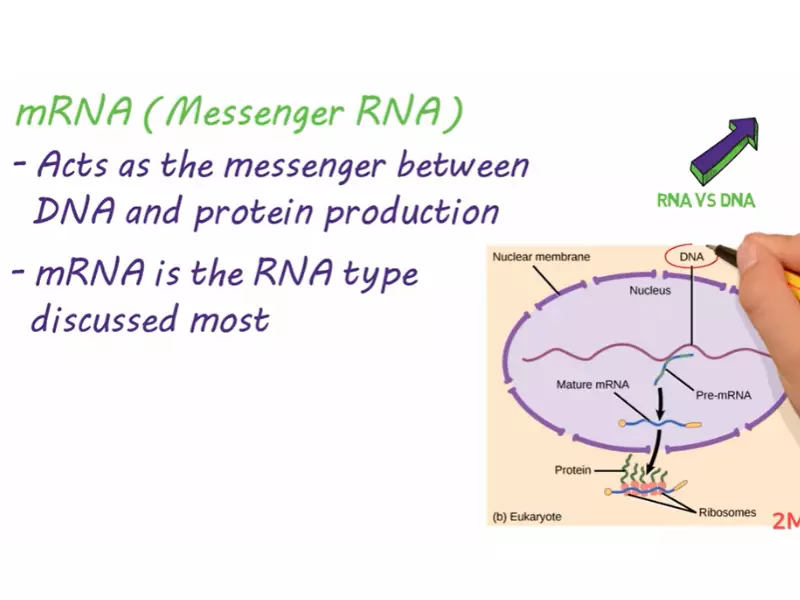RNA, or ribonucleic acid, is one of the fundamental molecules in the biology of cells, playing a crucial role in the process of translating genetic information into proteins. This molecule comes in various forms, each serving distinct functions within the cell. Among these, ribosomal RNA (rRNA) and messenger RNA (mRNA) are pivotal, yet they serve vastly different roles.
The difference between rRNA and mRNA lies primarily in their function and structure. rRNA is a key component of ribosomes, which are the cellular machinery responsible for protein synthesis. In contrast, mRNA carries the genetic blueprints from DNA to the ribosome, where these instructions are translated into proteins. This clear division of labor between rRNA and mRNA is central to the process of protein synthesis, ensuring the smooth operation of cellular activities.
Exploring the specifics, rRNA’s role revolves around forming the core of the ribosome’s structure and catalyzing peptide bond formation, making it crucial for the translational machinery. On the other hand, mRNA functions as the intermediary, conveying genetic information from DNA to the ribosome to guide the assembly of amino acids into proteins. Understanding these roles not only sheds light on how cells function at a molecular level but also highlights the elegant complexity of biological systems.

RNA Basics
Types of RNA
RNA, or ribonucleic acid, is a crucial molecule in cellular biology, essential for the synthesis of proteins and various other cellular functions. Three main types of RNA play vital roles within a cell: ribosomal RNA (rRNA), messenger RNA (mRNA), and transfer RNA (tRNA).
- rRNA forms the core structure of ribosomes, the cellular machines that synthesize proteins.
- mRNA carries genetic information from DNA to the ribosome, acting as a template for protein synthesis.
- tRNA brings the appropriate amino acids to the ribosome during protein synthesis, according to the sequence coded in the mRNA.
Role in Cells
Each type of RNA has a distinct function that is essential for the life of a cell. Together, they ensure that the genetic information contained within the DNA is accurately translated into proteins, which are the workhorses of the cell, performing a vast array of functions from catalyzing metabolic reactions to providing structural support.
rRNA Explained
Structure
rRNA molecules vary in size, but they all share a complex three-dimensional structure that allows them to combine with proteins to form ribosomes. These structures are not static; they undergo changes during the protein synthesis process to ensure efficient and accurate translation of mRNA into protein. rRNA consists of several components, including a large and a small subunit, each of which plays a specific role in protein synthesis.
Function
The primary function of rRNA is to form the catalytic core of ribosomes, where protein synthesis occurs. It not only provides a structural framework that brings mRNA and tRNA together but also catalyzes the formation of peptide bonds between amino acids, a process essential to building protein chains. Without rRNA, the translation of genetic information into functional proteins would be impossible.
mRNA Explained
Structure
mRNA molecules are single-stranded RNAs that vary in length depending on the gene they are transcribing. Their structure includes a coding region, which is a sequence of nucleotides that will be translated into protein, and typically untranslated regions (UTRs) at both ends, which play roles in the regulation of translation and mRNA stability. The structure of mRNA allows it to be efficiently processed and transported out of the nucleus and into the cytoplasm where it is translated.
Function
The function of mRNA is to serve as a template for protein synthesis. It carries the genetic code from DNA in the nucleus to the ribosome in the cytoplasm, where the code is read and translated into a specific sequence of amino acids, resulting in a protein. This process, known as gene expression, is fundamental to all living organisms, allowing the information encoded in genes to be manifested as proteins with specific functions.

Key Differences
Molecular Structure
Comparison of Physical Structures
rRNA and mRNA have distinctly different molecular structures that reflect their unique functions in the cell. rRNA molecules are complex and multi-component, forming the scaffolding of the ribosome’s structure. They are composed of both RNA sequences and protein complexes, creating a three-dimensional structure that is essential for their role in protein synthesis.
In contrast, mRNA is typically a single-stranded RNA molecule. It varies in length depending on the gene it transcribes and includes a coding region flanked by untranslated regions (UTRs). These UTRs play critical roles in the regulation of mRNA’s translation into proteins. The structure of mRNA is much simpler compared to rRNA, reflecting its primary role as a messenger carrying genetic information.
Biological Role
Distinct Functions in Protein Synthesis
The biological roles of rRNA and mRNA are both crucial yet distinct within the process of protein synthesis. rRNA’s role is primarily structural and catalytic within the ribosome. It ensures the correct assembly of the ribosome, facilitates the binding of mRNA and tRNA, and catalyzes the peptide bond formation between amino acids, directly contributing to the creation of protein chains.
On the other hand, mRNA’s function is to convey genetic information from DNA to the ribosome, where this information is translated into a specific protein. It acts as a template for protein synthesis, with each mRNA molecule coding for a specific protein. This critical role in gene expression allows for the diversity of proteins necessary for the organism’s life processes.
Synthesis Process
Transcription and Processing Differences
The synthesis processes of rRNA and mRNA in the cell highlight further differences between these two RNA types. rRNA genes are transcribed by RNA polymerase I in the nucleolus, a specialized region within the nucleus. The precursor rRNA (pre-rRNA) undergoes extensive modifications and cleavage to form mature rRNA, which then assembles with ribosomal proteins to form the ribosome’s subunits.
mRNA synthesis, however, involves RNA polymerase II and occurs throughout the nucleus. The initial mRNA transcript, known as pre-mRNA, undergoes several processing steps before it is considered mature and functional. These steps include the addition of a 5′ cap and a poly-A tail, as well as splicing to remove introns (non-coding regions). Only after these modifications can the mRNA be exported from the nucleus to the cytoplasm for translation.
Significance in Research
Medical Applications
Use in Treatments and Diagnostics
The study of rRNA and mRNA has significant implications for medicine, particularly in the development of new treatments and diagnostics. For instance, changes in mRNA expression can indicate the presence of diseases, including various cancers and genetic disorders. As such, mRNA profiles can be used for diagnostic purposes and to monitor the effectiveness of treatments.
Moreover, mRNA is now being exploited in therapeutic applications, such as in mRNA vaccines, which have been groundbreaking in the fight against infectious diseases like COVID-19. These vaccines use synthetic mRNA to encode viral proteins that, once expressed in the host cells, elicit an immune response, providing protection against the virus.
Biotechnology
Applications in Genetic Engineering
In biotechnology, the manipulation of rRNA and mRNA opens up possibilities for genetic engineering and the production of recombinant proteins. For instance, by modifying mRNA sequences, scientists can produce proteins with desired modifications or enhancements, which can be used in research, therapeutics, and the biopharmaceutical industry.
Similarly, understanding the structure and function of rRNA can lead to the development of antibiotics that specifically target bacterial ribosomes, inhibiting protein synthesis and effectively killing the bacteria. This research is crucial for addressing the growing issue of antibiotic resistance.
Frequently Asked Questions
What is RNA?
RNA, or ribonucleic acid, is a nucleic acid present in cells. It plays a vital role in the coding, decoding, regulation, and expression of genes. Different types of RNA, including mRNA and rRNA, perform various functions, such as carrying genetic information and facilitating protein synthesis.
How does rRNA differ from mRNA in protein synthesis?
rRNA and mRNA have distinct roles in protein synthesis. rRNA forms the structural and catalytic core of ribosomes, which synthesize proteins, whereas mRNA carries the genetic code from DNA, which guides the sequence of amino acids in a protein. Together, they enable the accurate translation of genetic information into functional proteins.
Why are rRNA and mRNA important in genetics?
rRNA and mRNA are fundamental to genetics because they are integral to gene expression and protein synthesis. mRNA’s role in carrying genetic information from DNA to the ribosome and rRNA’s role in the assembly of proteins are crucial for the functioning of all living cells, affecting everything from cellular structure to the regulation of genes.
Can changes in rRNA and mRNA affect health?
Yes, changes in rRNA and mRNA can significantly affect health. Mutations or alterations in the sequences of these RNAs can disrupt protein synthesis, leading to diseases. For example, mutations in mRNA can result in the production of faulty proteins, while changes in rRNA can affect ribosome function, both of which can contribute to various genetic disorders and cancers.
Conclusion
The exploration of rRNA and mRNA underscores the intricacy of cellular processes and the precise coordination required for life. These RNA types, with their distinct roles and structures, illustrate the complexity of genetic information translation into functional proteins. Such understanding not only deepens our appreciation of biological systems but also opens avenues for medical and biotechnological advancements.
Recognizing the pivotal differences between rRNA and mRNA enriches our comprehension of cellular machinery and its impact on health and disease. As science advances, the knowledge of how these RNAs operate and interact within the cell will continue to be crucial for developing genetic therapies and innovations in biotechnology, marking an ongoing journey into the molecular heart of life itself.
